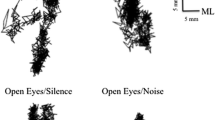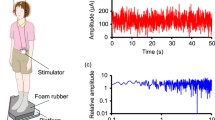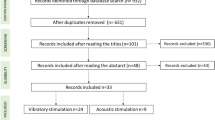Abstract
The importance of sensory feedback for postural control in stance is evident from the balance improvements occurring when sensory information from the vestibular, somatosensory, and visual systems is available. However, the extent to which also audio-biofeedback (ABF) information can improve balance has not been determined. It is also unknown why additional artificial sensory feedback is more effective for some subjects than others and in some environmental contexts than others. The aim of this study was to determine the relative effectiveness of an ABF system to reduce postural sway in stance in healthy control subjects and in subjects with bilateral vestibular loss, under conditions of reduced vestibular, visual, and somatosensory inputs. This ABF system used a threshold region and non-linear scaling parameters customized for each individual, to provide subjects with pitch and volume coding of their body sway. ABF had the largest effect on reducing the body sway of the subjects with bilateral vestibular loss when the environment provided limited visual and somatosensory information; it had the smallest effect on reducing the sway of subjects with bilateral vestibular loss, when the environment provided full somatosensory information. The extent that all subjects substituted ABF information for their loss of sensory information was related to the extent that each subject was visually dependent or somatosensory-dependent for their postural control. Comparison of postural sway under a variety of sensory conditions suggests that patients with profound bilateral loss of vestibular function show larger than normal information redundancy among the remaining senses and ABF of trunk sway. The results support the hypothesis that the nervous system uses augmented sensory information differently depending both on the environment and on individual proclivities to rely on vestibular, somatosensory or visual information to control sway.





Similar content being viewed by others
References
Barclay-Goddard R, Stevenson T, Poluha W, Moffatt M, Taback S (2004) Force platform feedback for standing balance training after stroke. Cochrane Database Syst RevCD004129
Batavia M, Gianutsos JG, Vaccaro A, Gold JT (2001) A do-it-yourself membrane-activated auditory feedback device for weight bearing and gait training: a case report. Arch Phys Med Rehabil 82:541–545
Black FO, Nashner LM (1984) Vestibulo-spinal control differs in patients with reduced versus distorted vestibular function. Acta Otolaryngol Suppl 406:110–114
Black FO, Paloski WH, Reschke MF, Igarashi M, Guedry F, Anderson DJ (1999) Disruption of postural readaptation by inertial stimuli following space flight. J Vestib Res 9:369–378
Black FO, Shupert CL, Horak FB, Nashner LM (1988) Abnormal postural control associated with peripheral vestibular disorders. Prog Brain Res 76:263–275
Buchanan JJ, Horak FB (2001) Vestibular loss disrupts control of head and trunk on a sinusoidally moving platform. J Vestib Res 11:371–389
Chiari L, Dozza M, Cappello A, Horak FB, Macellari V, Giansanti D (2005) Audio-biofeedback for balance improvement: an accelerometry-based system. IEEE Trans Biomed Eng 52:2108–2111
Creath R, Kiemel T, Horak F, Jeka JJ (2002) Limited control strategies with the loss of vestibular function. Exp Brain Res 145:323–333
Creath R, Kiemel T, Horak F, Peterka R, Jeka J (2005) A unified view of quiet and perturbed stance: simultaneous co-existing excitable modes. Neurosci Lett 377:75–80
Dault MC, Frank JS (2004) Does practice modify the relationship between postural control and the execution of a secondary task in young and older individuals? Gerontology 50:157–164
Dickstein R, Shupert CL, Horak FB (2001) Fingertip touch improves postural stability in patients with peripheral neuropathy. Gait Posture 14:238–247
Dozza M, Chiari L, Chan B, Rocchi L, Horak FB, Cappello A (2005a) Influence of a portable audio-biofeedback device on structural properties of postural sway. J Neuroengineering Rehabil 2:13
Dozza M, Chiari L, Horak FB (2005b) Audio-biofeedback improves balance in patients with bilateral vestibular loss. Arch Phys Med Rehabil 86:1401–1403
Easton RD, Greene AJ, DiZio P, Lackner JR (1998) Auditory cues for orientation and postural control in sighted and congenitally blind people. Exp Brain Res 118:541–550
Forbes TW (1946) Auditory signals for instrument flying. J Aeronaut Soc 255–258
Gage WH, Winter DA, Frank JS, Adkin AL (2004) Kinematic and kinetic validity of the inverted pendulum model in quiet standing. Gait Posture 19:124–132
Gagey PM, Toupet M (1991) Orthostatic postural control in vestibular neuritis: a stabilometric analysis. Ann Otol Rhinol Laryngol 100:971–975
Hegeman J, Honegger F, Kupper M, Allum JH (2005) The balance control of bilateral peripheral vestibular loss subjects and its improvement with auditory prosthetic feedback. J Vestib Res 15:109–117
Horak FB, Buchanan J, Creath R, Jeka J (2002) Vestibulospinal control of posture. Adv Exp Med Biol 508:139–145
Horak FB, Hlavacka F (2001) Somatosensory loss increases vestibulospinal sensitivity. J Neurophysiol 86:575–585
Horak FB, Macpherson JM (1996) Postural equilibrium and orientation. In: Rowell RB, Shepherd JT (eds) Published for the American Physiology Society by Oxford University Press, New York, pp 255–292
Hufschmidt A, Dichgans J, Mauritz KH, Hufschmidt M (1980) Some methods and parameters of body sway quantification and their neurological applications. Arch Psychiatr Nervenkr 228:135–150
Jeka J, Oie KS, Kiemel T (2000) Multisensory information for human postural control: integrating touch and vision. Exp Brain Res 134:107–125
Kentala E, Vivas J, Wall C III (2003) Reduction of postural sway by use of a vibrotactile balance prosthesis prototype in subjects with vestibular deficits. Ann Otol Rhinol Laryngol 112:404–409
Kluzik J, Horak FB, Peterka RJ (2005) Differences in preferred reference frames for postural orientation shown by after-effects of stance on an inclined surface. Exp Brain Res 162:474–489
van der Kooij H, Jacobs R, Koopman B, van der HF (2001) An adaptive model of sensory integration in a dynamic environment applied to human stance control. Biol Cybern, pp. 103–115
Kuo AD, Speers RA, Peterka RJ, Horak FB (1998) Effect of altered sensory conditions on multivariate descriptors of human postural sway. Exp Brain Res 122:185–195
Lackner JR (1974) The role of posture in sound localization. Q J Exp Psychol 26:235–251
Lackner JR, DiZio PA (2000) Aspects of body self-calibration. Trends Cogn Sci 4:279–288
Lacour M, Barthelemy J, Borel L, Magnan J, Xerri C, Chays A, Ouaknine M (1997) Sensory strategies in human postural control before and after unilateral vestibular neurotomy. Exp Brain Res 115:300–310
Macpherson JM, Inglis JT (1993) Stance and balance following bilateral labyrinthectomy. Prog Brain Res 97:219–228
Maurer C, Mergner T, Peterka RJ (2004) Abnormal resonance behavior of the postural control loop in Parkinson’s disease. Exp Brain Res 157:369–376
Mayagoitia RE, Lotters JC, Veltink PH, Hermens H (2002) Standing balance evaluation using a triaxial accelerometer. Gait Posture 16:55–59
Nashner LM, Black FO, Wall C III (1982) Adaptation to altered support and visual conditions during stance: patients with vestibular deficits. J Neurosci 2:536–544
Nelson WT, Hettinger LJ, Cunningham JA, Brickman BJ, Haas MW, McKinley RL (1998) Effects of localized auditory information on visual target detection performance using a helmet-mounted display. Hum Factors 40:452–460
Nichols DS (1997) Balance retraining after stroke using force platform biofeedback. Phys Ther 77:553–558
Paloski WH, Reschke MF, Black FO, Doxey DD, Harm DL (1992) Recovery of postural equilibrium control following spaceflight. Ann N Y Acad Sci 656:747–754
Peterka RJ (2002) Sensorymotor integration in human postural control. J Neurophysiol 88:1097–1118
Peterka RJ, Black FO (1990) Age-related changes in human posture control: sensory organization tests. J Vestib Res 1:73–85
Prieto TE, Myklebust JB, Hoffmann RG, Lovett EG, Myklebust BM (1996) Measures of postural steadiness: differences between healthy young and elderly adults. IEEE Trans Biomed Eng 43:956–966
Redfern MS, Talkowski ME, Jennings JR, Furman JM (2004) Cognitive influences in postural control of patients with unilateral vestibular loss. Gait Posture 19:105–114
Rocchi L, Chiari L, Cappello A (2004) Feature selection of stabilometric parameters based on principal component analysis. Med Biol Eng Comput 42:71–79
Schumacher EH, Seymour TL, Glass JM, Fencsik DE, Lauber EJ, Kieras DE, Meyer DE (2001) Virtually perfect time sharing in dual-task performance: uncorking the central cognitive bottleneck. Psychol Sci 12:101–108
Shumway-Cook A, Horak FB (1990) Rehabilitation strategies for patients with vestibular deficits. Neurol Clin 8:441–457
Shumway-Cook A, Horak FB, Yardley L, Bronstein AM (1996) Rehabilitation of balance disorders in the patient with vestibular pathology. In: Bronstein AM, Brandt T, Woollacott MH (eds) Clinical disorders of balance, posture and gait. Arnold London, pp 213–220
Shumway-Cook A, Woollacott M, Kerns KA, Baldwin M (1997) The effects of two types of cognitive tasks on postural stability in older adults with and without a history of falls. J Gerontol A Biol Sci Med Sci 52:M232–M240
Tyler M, Danilov Y, Bach-y-Rita P (2003) Closing an open-loop control system: vestibular substitution through the tongue. J Integr Neurosci 2:159–164
Vinge E. Human operator for aural compensatory tracking. Proceedings of the 7th Annual Conference on Maual Control (NASA SP-281). 1971. U.S. Government Printing Office.
Vuillerme N, Nafati G (2005) How attentional focus on body sway affects postural control during quiet standing. Psychol Res, pp. 1–9
Wall C III, Weinberg MS, Schmidt PB, Krebs DE (2001) Balance prosthesis based on micromechanical sensors using vibrotactile feedback of tilt. IEEE Trans Biomed Eng 48:1153–1161
Wickens CD, Hollands JG (2000) Engineering Phychology and Human Performance. New Jersey
Wong AM, Lee MY, Kuo JK, Tang FT (1997) The development and clinical evaluation of a standing biofeedback trainer. J Rehabil Res Dev 34:322–327
Woollacott MH (1993) Age-related changes in posture and movement. J Gerontol 48 Spec No: 56–60
Zacharias GL, Young LR (1981) Influence of combined visual and vestibular cues on human perception and control of horizontal rotation. Exp Brain Res 41:159–171
Acknowledgments
We would like to thank Dr. Conrad Wall and Dr. Angelo Cappello for stimulating inspiration, Dr. Sandra Oster for English editing and education, Andrew Owings and Dr. Charles Russell for technical support, Triana Nagel-Nelson for recruitment of subjects, and all of our subjects for donating their time. We also thank Dr. Velio Macellari and Dr. Daniele Giansanti for having made available the portable measurement system. This study was supported by NIH grants DC01849, DC04082, and DC06201.
Author information
Authors and Affiliations
Corresponding author
Rights and permissions
About this article
Cite this article
Dozza, M., Horak, F.B. & Chiari, L. Auditory biofeedback substitutes for loss of sensory information in maintaining stance. Exp Brain Res 178, 37–48 (2007). https://doi.org/10.1007/s00221-006-0709-y
Received:
Accepted:
Published:
Issue Date:
DOI: https://doi.org/10.1007/s00221-006-0709-y




